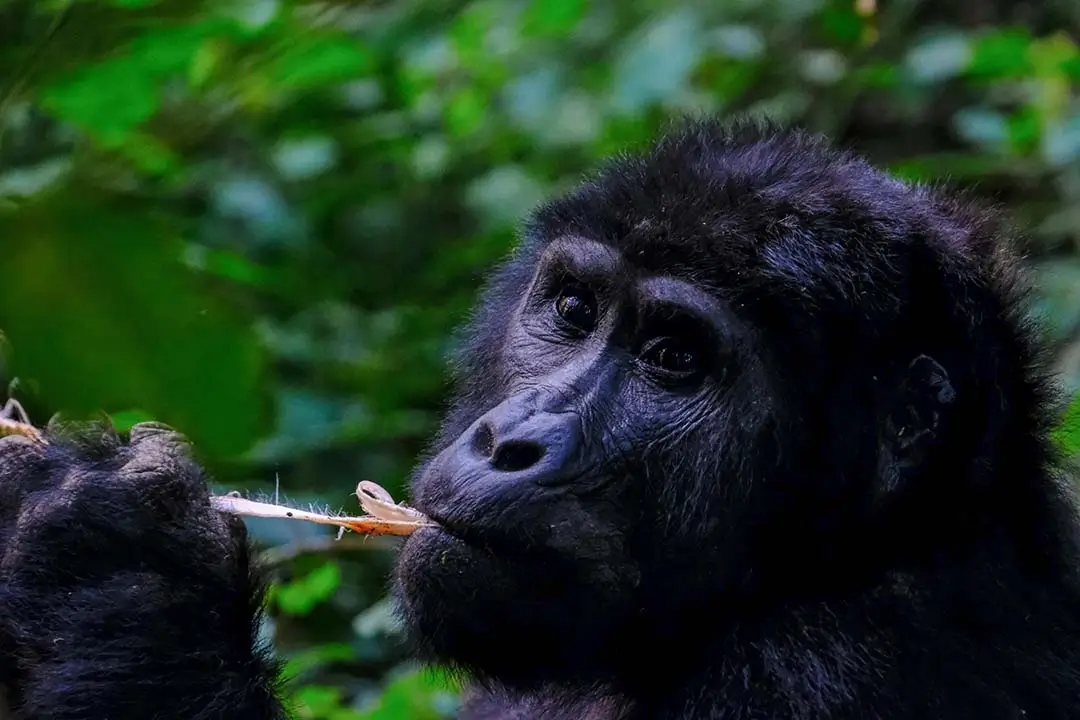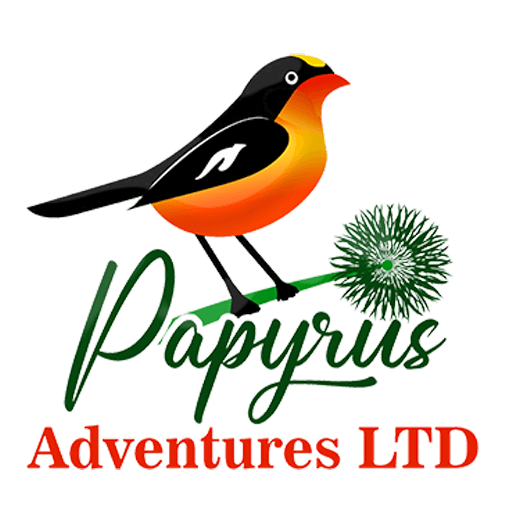Zoologists were introduced to the Mountain Gorilla in 1903 when Captain Friedrich Robert von Beringe shot two gorillas on the slopes of Mt. Sabinyo currently Rwanda. Presently, the gorilla population is split between Virunga mountain ranges covering the border region between Rwanda, Uganda, and Democratic Republic of Congo. Gorilla trekking is done in Volcanoes National Park located 116km/72miles and 2 hours drive away from the capital city Kigali in Musanze District north of Rwanda. A third of the world's gorilla population is found in Volcanoes National Park.
The mountain gorilla is a very large, barrel-chested ape, very black, densely-furred to protect against the cold with a broad face. Mountain gorillas are very sociable and exist in groups of between 5 to 50 individuals. The group will be led by one dominant 'silverback' (silver hairs start to grow in the saddle of the back). An adult male is usually 13 years old. In the gorilla community the silverback eats first, but is also accountable for the defense of the group, a feature that allows gorillas to spend more time on the ground than other great apes.
When the silverback dies, his group usually splits. When two groups move close to one another, they will avoid contact in order to minimize the risk of conflict. The mountain gorilla has a limited diet than lowland gorillas. They feed mostly on bamboo, leaves, shoots and stems of over 140 other species, wild celery and vines. Gorillas spend much of the day resting, which provides such a great opportunity for trekkers to join and observe the group.
Reproduction occurs progressively, with adult females over the age of eight giving birth on average one every four years and often not more than six in a lifetime. The young gorillas have a lengthy childhood where they are ferociously protected by both the females and the dominant silverback. The incoming dominant male will habitually kill the young gorillas in a case where the silverback dies or is pushed from the group. The females always protect a dominant silverback when it is threatened. The protection and slow population growth of the gorillas can be attributed to tourists who come to visit them. Without this critical finance, the incentives to protect the gorillas and their environment would be reduced, and we might not have gorillas left in their natural habitats today.
Gorilla trekking entails going on a guided hike through impenetrable rainforest to spend time with a specific habituated gorilla group in their innate environment. There are 12 habituated mountain gorilla families in the Volcanoes National Park ready for trekking. Habituation of gorillas is the process by which trained people like rangers make continuous visits to a group of wild gorillas in the jungle whose instinct is to flee or attack a human because they perceive him or her an intruder in their natural space and thus a threat, to a point the gorillas will believe that the humans are actually not a threat after realizing they are not being harmed by these persistent human visitors. At this point the gorillas can tolerate the humans in their vicinity but for a short while.
When American naturalist Dian Fossey moved to Rwanda half a century ago to study mountain gorillas, their numbers were dwindling, down to just 254 individuals, but today they're up to over 600, with another 400 in Uganda. Tourists play a vital role in the joint effort with scientists and governments to save the gorillas and communities around them. The Rwandan government regulates the visits to no more than eight people per group, for one hour with the gorillas, with precautions taken to protect them from human illness.
Rwanda Gorilla Conservation
Biological research on mountain gorillas by teams of researchers provides important information on trends to allow sound tourism management. The Karisoke Research Centre in Rwanda is the longest-running wildlife research project. The Virunga volcanoes range has an estimate of about 380 gorillas with 260 habituated and monitored in Rwanda. Rwanda is too much in to gorilla conservation and below is how they do it;
- The gorillas are checked on a daily basis. Health reports are shared and actions taken when necessary
- Though the use of Information Technology, mapping the habitat of the gorillas to show where the gorilla groups are moving, what illegal activities are found and plans to patrol are arranged.
- The habitat is patrolled daily to detect illegal activities and discourage any attempt to put snares in the park;
- The government is supportive of gorilla conservation through its programs like allocation of more land around the park for cultivation. Part of the revenues from the national parks is primarily used to fund the conservation of all three national parks. Salaries for all of the staff are paid out of national park fees.
- Volcanoes National Park management is co-funded through the research activities of the Karisoke Research Centre, which provides basic park management functions such as monitoring and anti-poaching patrols amongst the research groups for gorillas.
- An “Ex-poachers Association” consists of about 400 local community members, who have stopped poaching in the park. Some ex-poachers have begun to work on conservation efforts. They do patrols with ORTPN staff, and also help with local education, collecting information, and addressing human-wildlife conflict
- Further funds are invested from other NGOs including the International Gorilla Conservation Program and CARE for park management and also community conservation. These additional funds and support contribute enormously to the current success story of gorillas in Rwanda.
Do You have any Questions?
Our Experts are ready to provide answers
Gorilla Families in Rwanda
Susa family
- Usually found high up on Mount Karisimbi, which are relatively more challenging to hike.
- Studied by Dian Fossey. Group is known for having rare twins named Impano and Byishimo.
- Susa (A) gorilla family is the Largest with about 41 individuals, including 3 silverbacks.
- Family ranges in the high mountains making it difficult to trek, but rewards you with its size on sighting it.
Karisimbi/Susa (B) family
- Split from the original Susa (A) group and has 2 silverbacks. Hardest to trek, living on the upper slopes of Mt Karisimbi. Requires a full day to hike.
Amahoro family
- Has 17 gorilla members led by Ubumwe. Furthest from the park headquarters.
- Amahoro means peaceful. They resides uphill and tourists have to climb a steep
- Found between Karisoke and the Visoke peaks of the Volcanoes.
Sabinyo gorilla family
- Led by Guhonda, and named after one of the volcanoes called Mt Sabyinyo.
- Found between Mt. Sabinyo and Gahinga. It has about 12 individuals, with a couple of silverbacks in the group.
- Closest to the park headquarters and is good for short distance trackers.
Hirwa gorilla family
- Arose from different existing gorilla families including Group 13, Susa and Sabyinyo.
- Has 11 members including a pair of twins
- Munyinya the dominant silverback left Susa group with 2 females, got others along the way and in due course formed a group
Agashya gorilla family
- Found close to the Sabinyo group.
- Previously known as “Group Thirteen which had 13 members during habituation.
- Has about 25 gorillas including two silverbacks.
- Led by silverback Agashya which explains the name change.
Kwitonda gorilla family
- Headed by silverback Kwitonda and the name is interpreted as the humble one.
- Has 18 members and was habituated in the DRC. They crossed the border into Rwanda in 2005, and are now open for visitation.
- Most challenging to trek as it's in the upper slopes of Mt Muhabura.
Umubano gorilla family
- Led by silverback Charles who broke off from Amahoro gorilla group with some females to form Umubano. Umubano is translated as living together.
Bwenge gorilla family
- Group inhabits mainly the slopes between Karisimbi and Bisoke mountains.
- Formed by silverback Bwenge after breaking away with females from other groups.
- Bwenge is interpreted to mean wisdom.
The Ugende Gorilla family
- Has 11 members who are always on the move to new places. Quite difficult to trace and track.
- Roams around Karisimbi area.
- Name means on the move.
Titus gorilla family
- Named after silverback Titus which was born during the days of Dian Fossey research at Karisoke.
Travel With Us
When considering your next adventure, Papyrus Adventures stands out as the ideal travel companion, offering a comprehensive package of benefits that ensure an unparalleled experience.
Best Price Guaranteed
With our "Best Price Guaranteed" policy, you can rest assured that you are getting the most value for your investment.
Professional Safari Guides
Our commitment to excellence extends to our team of "Professional Safari Guides," who possess extensive knowledge and expertise, ensuring a journey filled with insightful and unforgettable moments.
Locally Owned Company
Papyrus Adventures is deeply rooted in the destinations we explore, allowing us to provide authentic and immersive experiences that showcase the rich cultures and landscapes of each location.
24-7 Customer Support
our "24-7 Customer Support" ensures that your needs are met around the clock, providing peace of mind and a safety net for any unforeseen circumstances.
Rwanda gorilla permit
The cost of the permit for trekking gorilla in Rwanda is 1500 USD.
The Volcanoes National Park local communities take a share of 10% of this fee for development projects. This has encouraged the community to protect the park at all costs. Some of the community members were hunters, poachers and depended on park area for herbs, firewood and agriculture. As a tourist when you buy the Rwanda gorilla permit know that you are contributing to the development of the local community and conserving the gorillas.
Do You have any Questions?
Our Experts are ready to provide answers
Rwanda gorilla tracking guidelines, rules and regulations
These rules were designed and set to lessen disease transmission and behavioral disturbance to the gorillas from tourists. A number of rules designed to protect both gorillas and tourists include;
- Then minimum age for tourists visiting the gorillas is 15 years and above.
- A maximum of eight tourists per visit per group.
- Tourists that are not feeling well or sick are not allowed to see the gorillas to prevent transmission of diseases to them.
- Tourist should maintain of a distance of 7 meters between them and the gorillas.
- One tourist group is allowed per each gorilla group.
- Tourists are allowed a maximum of one her with the gorillas.
- While with the gorillas, no flash photography is allowed.
- Tourists must remain together in a tight group.
- While in the presence of gorillas no loud noises or pointing fingers at the gorillas.
- While with the gorillas, tourists are not allowed to eat, drink or smoke.
- In case of coughing and sneezing, tourists must turn away and cover their mouths.
- Tourists are not allowed to clear away vegetation to get a better view.
- No trash should be dropped in the park
- In case you want to ease yourself, your guide will direct you when to dig a hole of 30 centimeters where the feces will be buried.
Frequently Asked Questions About Gorilla Trekking in Rwanda
Volcanoes National Park has 10 mountain gorilla groups in different sizes and in different habitats of the park. Groups don't stay in one place. Trackers head out every morning to locate the groups. The tough part about trekking gorillas is the tricky terrain and high humidity levels are toughest to hike. Tourists with an equitable fitness level can manage the trek. Expect to get sweaty or even muddy on you hike. Sometimes tourists will experience altitude sickness since gorillas leave at altitudes of 2200 to 3000 meters. Porters are available to help carry you bag and help you through the terrain.
Gorilla sightings are guaranteed irrespective of the weather. The dry season of June to September, December to January is the best time to trek gorillas.



